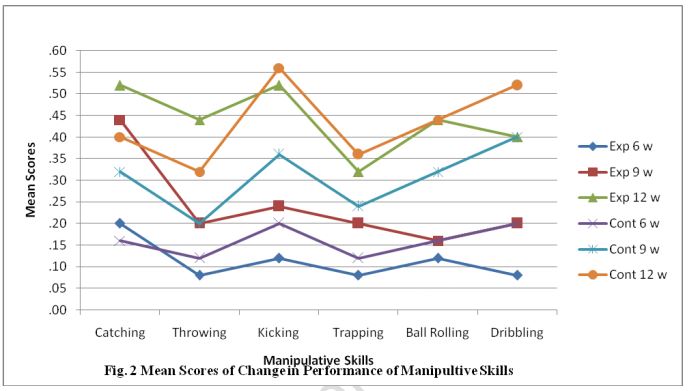EFFECT OF STRUCTURED PHYSICAL EDUCATION PROGRAM ON FUNDAMENTAL MOTOR SKILL DEVELOPMENT OF CHILDREN BETWEEN 5 TO 6 YEARS OF AGE
Abstract
The purpose of this research was to study the effect of Structured Physical Education Program (SPEP) on Fundamental Motor Skill (FMS) development of children between 5 to 6 years of age. For this experimental research, 50 children from Challenger Public School, Pune were selected using non - probability based convenience sampling technique, 25 of which formed the control group and 25 formed the experimental group. The experimental group underwent a 12 week SPEP designed by the researcher which consisted of locomotor and manipulative skills based on the Physical Education (PE) framework. The control group underwent the regular PE program for the same duration. The performance of the children was observed 4 times i.e. once before commencement of the SPEP, after 6, 9 and 12 weeks using researcher designed assessment tool, where the FMS were divided into sub- skills that were rated on a 5 point scale. Based on all the 4 observations, Paired Sample ‘t’ test was computed to study the effect of 6 weeks, 9 weeks and12 weeks of SPEP separately, which showed 6 weeks, 9 weeks and 12 weeks of SPEP had significant effect on all the locomotor skills except walking. Similarly only 9 weeks and 12 weeks of SPEP had significant effect on all the manipulative skills.Change in performance i.e. the effect of 6 weeks, 9 weeks and 12 weeks were calculated and compared using Paired Sample ‘t’ test which showed that there was significant improvement in 6 weeks and 9 weeks of SPEP, after which plateau was observed in the improvement of the same. Similarly in case of manipulative skills, no significant improvement was observed in 6 weeks, 9 weeks and 12 weeks of SPEP. Independent Sample ‘t’ Test was administered to compare the effect of 6 weeks, 9 weeks and 12 weeks between the groups which showed, as compared to the control group, in experimental group, there was significant effect of 6 weeks, 9 weeks and 12 weeks of SPEP in case of the locomotor skills except walking. Similarly, there was no significant effect of 6 weeks, 9 weeks and 12 weeks of SPEP in case of all the manipulative skills. Hence it was concluded that there was significant effect of SPEP on all the FMS components (except walking).
Downloads
References
Apache, R.R., 2005. Activity-based intervention in motor skill development. Perceptual and Motor Skills, 100: 1011-1020.
Barnett LM, van Beurden E, Morgan PJ, Brooks LO, and Beard JR (2009) Childhood motor skill proficiency as a predictor of adolescent physical activity. Journal of Adolescent Health 44: 252–259.
Bovens, A. M., Van Baak, M. A., Vrencken, J. G., Wijnen, J. A., Saris, W. H., &Verstappen, F. T. (1993). Physical activity, fitness and selected risk factors for CHD in active men and women.Medicine and Science in Sports and Exercise. 25. 572-576.
Clark, J. E. (1994). Motor development.In V. S. Ramachandran (Ed.), Encyclopedia of Human Behavior, (Vol. 3, pp. 249-255). San Diego: Academic Press.
Corbin, C. B., &Pangrazzi, R. P. (1993).The health benefits of physical activity. Physical Activity and Fitness Research Digest.Series 1, No.l.
Davis, W.E. and A.W. Burton, 1991.Ecological task analysis: Translating movement behavior theory into practice. Adapted Physical Activity Quarterly, 8: 154-177.
Gabbard, C. P. (2000). Lifelong Motor Development (3rd ed). Madison, Dubuque, IA: Brown & Benchmark.
Gallahue, D.L. and F.C. Donnelly, 2003.Developmental Physical Education for all Children,Movement Skill Acquisition. Human Kinetics, 4th Ed., Champaign, pp: 257-75.
Gallahue, D.L., J.C. Ozmon, 2006. Selected factor motor development. In: Understanding Motor Development: Infants, Children, Adolescents, Adult with Power Web. Mac Grew Hill, 6th Ed., York, pp: 48-74.
Gallahue DL, Ozmun J (2002) Understanding Motor Development: Infants, Children, Adolescents, Adults. 5th ed. New York: McGraw-Hill.
Haga M (2008) The relationship between physical fitness and motor competence in children. Child: Care, Health and Development 34(3): 329–334.
Haywood, K. M., & Getchell, N. (2002).Lifespan Motor Development (f* ed).Champagne, IL: Human Kinetics.
Payne, V.G. and L.D. Isaacs, 2002.Human Motor Development: A Life Span Approach. Mountain View, 5th Ed., California, pp: 434-435.
Powell, K. E., & Blair, S. N. (1994).The public health burdens of sedentary living habits: Theoretical but realistic estimates. Medicine and Science in Sports and Exercise. 26. 851- 856.
Walberg, J., & Ward, D. (1985).Role of physical activity in the etiology and treatment of childhood obesity.Pediatrician. 12. 82-88.















